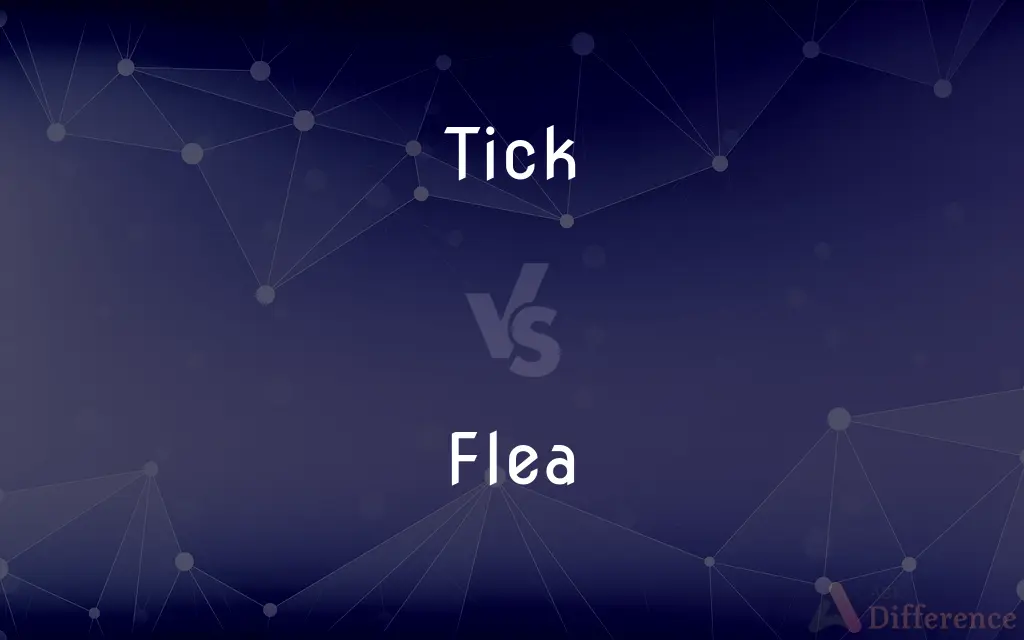Tick vs. Flea — What's the Difference?
By Fiza Rafique & Urooj Arif — Updated on April 18, 2024
Ticks are arachnids that attach to hosts for long periods, while fleas are insects that jump between hosts but do not stay attached.

Difference Between Tick and Flea
Table of Contents
ADVERTISEMENT
Key Differences
Ticks are part of the arachnid family, which includes spiders and scorpions, and have eight legs. They attach themselves to their hosts for long periods, ranging from several hours to days, to feed on blood. In contrast, fleas are insects belonging to the order Siphonaptera and have six legs. They are known for their incredible jumping abilities and do not stay attached to their hosts; instead, they make quick visits for feeding.
While ticks can transmit a variety of diseases to their hosts, such as Lyme disease and Rocky Mountain spotted fever, by staying attached and slowly feeding, fleas are vectors for different diseases like the bubonic plague and typhus. Fleas are also notorious for causing severe allergic reactions in pets, specifically flea allergy dermatitis.
Ticks are generally larger than fleas, making them easier to spot and remove. They often require careful removal to ensure that their mouthparts do not remain embedded in the skin. Fleas, being smaller and more agile, can be more difficult to catch and require different strategies, such as extensive cleaning and the use of pesticides, to effectively control.
In their life cycle, ticks go through four stages: egg, larva, nymph, and adult, requiring a blood meal to progress to each successive stage. Fleas, however, hatch from eggs into tiny larvae that feed on organic debris found in their environment, not blood, before maturing into blood-sucking adults.
Ticks tend to be more active in cooler weather and can often be found in tall grasses and wooded areas, waiting to attach to a passing host. Fleas prefer warmer, humid conditions and are often found in carpets, bedding, and furniture within a home environment, making them a year-round concern for pet owners.
ADVERTISEMENT
Comparison Chart
Classification
Arachnids (eight legs)
Insects (six legs)
Attachment to Host
Attach and remain for extended periods
Jump on and off quickly, do not stay attached
Diseases Spread
Lyme disease, Rocky Mountain spotted fever
Bubonic plague, typhus, flea allergy dermatitis
Size
Larger, easier to spot
Smaller, harder to detect and eliminate
Life Cycle Stages
Egg, larva, nymph, adult
Egg, larva, pupa, adult
Environmental Preference
Cooler climates, tall grasses, wooded areas
Warmer, humid conditions, indoors like carpets and furniture
Removal Methods
Must be carefully removed to avoid leaving parts behind
Require pesticides, extensive cleaning
Compare with Definitions
Tick
Can transmit diseases through prolonged attachment.
Tick bites can lead to Lyme disease if not treated properly.
Flea
A small jumping insect, feeding on blood from various hosts.
The dog was infested with fleas after the beach trip.
Tick
A blood-sucking arachnid, typically attaching to a single host.
He found a tick attached to his leg after hiking.
Flea
Lives and breeds in household fabrics.
Regular vacuuming is needed to control fleas in carpeted areas.
Tick
Requires careful removal to avoid infection.
Use tweezers to remove a tick by pulling it out gently and steadily.
Flea
Rapid life cycle, with potential for quick infestation.
Flea populations can explode in warm conditions within days.
Tick
Goes through four life stages, each requiring a blood meal.
The tick must feed to advance from the larval to the nymph stage.
Flea
Transmits diseases and parasites like tapeworms.
Fleas are carriers for tapeworm eggs that can infect pets.
Tick
Active in cooler weather, often found in wooded areas.
Wear long sleeves and pants to protect against ticks in the forest.
Flea
Known for causing allergic reactions in animals.
His cat developed flea allergy dermatitis from flea bites.
Tick
Ticks (suborder Ixodida) are parasitic arachnids that are part of the superorder Parasitiformes. Along with mites, they constitute the subclass Acari.
Flea
Flea, the common name for the order Siphonaptera, includes 2,500 species of small flightless insects that survive as external parasites of mammals and birds. Fleas live by consuming blood, or hematophagy, from their hosts.
Tick
A light, sharp, clicking sound made repeatedly by a machine, such as a clock.
Flea
Any of various small, wingless, bloodsucking insects of the order Siphonaptera that are parasitic on mammals and birds and can jump long distances.
Tick
Chiefly British A moment.
Flea
Any of various small crustaceans that resemble or move like fleas, such as the water flea.
Tick
A light mark used to check off or call attention to an item.
Flea
A small, wingless, parasitic insect of the order Siphonaptera, renowned for its bloodsucking habits and jumping abilities.
Tick
(Informal)A unit on a scale; a degree
When interest rates move up a tick.
Flea
(derogatory) A thing of no significance.
Tick
Any of various small bloodsucking arachnids of the order Ixodida that are parasitic on terrestrial vertebrates. Many species transmit diseases, such as Rocky Mountain spotted fever and Lyme disease.
Flea
(transitive) To remove fleas from (an animal).
Tick
Any of various usually wingless insects that resemble a tick, such as a sheep ked.
Flea
Obsolete spelling of flay
Tick
A cloth case for a mattress or pillow.
Flea
To flay.
He will be fleaed firstAnd horse collars made of's skin.
Tick
A light mattress without inner springs.
Flea
An insect belonging to the genus Pulex, of the order Aphaniptera. Fleas are destitute of wings, but have the power of leaping energetically. The bite is poisonous to most persons. The human flea (Pulex irritans), abundant in Europe, is rare in America, where the dog flea (Ctenocephalides canis, formerly Pulex canis) and the smaller cat flea (Ctenocephalides felis) take its place. See Aphaniptera, and Dog flea. See Illustration in Appendix.
Tick
Ticking.
Flea
Any wingless blood-sucking parasitic insect noted for ability to leap
Tick
Credit or an amount of credit.
Tick
To emit recurring clicking sounds
As the clock ticked.
Tick
To function characteristically or well
Machines ticking away.
Curious about what makes people tick.
Tick
To count or record with the sound of ticks
A clock ticking the hours.
A taxi meter ticking the fare.
Tick
To mark or check off (a listed item) with a tick
Ticked off each name on the list.
Tick
A relatively quiet but sharp sound generally made repeatedly by moving machinery.
The steady tick of the clock provided a comforting background for the conversation.
Tick
A mark on any scale of measurement; a unit of measurement.
At midday, the long bond is up a tick.
Tick
(computing) A jiffy (unit of time defined by basic timer frequency).
Tick
(colloquial) A short period of time, particularly a second.
I'll be back in a tick.
Tick
(video games) A periodic increment of damage or healing caused by an ongoing status effect.
Tick
A mark (✓) made to indicate agreement, correctness or acknowledgement.
Indicate that you are willing to receive marketing material by putting a tick in the box
Tick
(birdwatching) A bird seen (or heard) by a birdwatcher, for the first time that day, year, trip, etc., and thus added to a list of observed birds.
Tick
(uncountable) Ticking.
Tick
A sheet that wraps around a mattress; the cover of a mattress, containing the filling.
Tick
Credit, trust.
Tick
A goat.
Tickhill, Tickham, Ticknock, Tickenhall Drive, Tickenhill Manor, Tickenhurst
Tick
To make a clicking noise similar to the movement of the hands in an analog clock.
Tick
To make a tick or checkmark.
Tick
To work or operate, especially mechanically.
He took the computer apart to see how it ticked.
I wonder what makes her tick.
Tick
To strike gently; to pat.
Tick
To add (a bird) to a list of birds that have been seen (or heard).
Tick
(intransitive) To go on trust, or credit.
Tick
(transitive) To give tick; to trust.
Tick
Credit; trust; as, to buy on, or upon, tick.
Tick
Any one of numerous species of large parasitic mites which attach themselves to, and suck the blood of, cattle, dogs, and many other animals. When filled with blood they become ovate, much swollen, and usually livid red in color. Some of the species often attach themselves to the human body. The young are active and have at first but six legs.
Tick
The cover, or case, of a bed, mattress, etc., which contains the straw, feathers, hair, or other filling.
Tick
A quick, audible beat, as of a clock.
Tick
Any small mark intended to direct attention to something, or to serve as a check.
Tick
The whinchat; - so called from its note.
Tick
To go on trust, or credit.
Tick
To give tick; to trust.
Tick
To make a small or repeating noise by beating or otherwise, as a watch does; to beat.
Tick
To strike gently; to pat.
Stand not ticking and toying at the branches.
Tick
To check off by means of a tick or any small mark; to score.
When I had got all my responsibilities down upon my list, I compared each with the bill and ticked it off.
Tick
A metallic tapping sound;
He counted the ticks of the clock
Tick
Any of two families of small parasitic arachnids with barbed proboscis; feed on blood of warm-blooded animals
Tick
A mark indicating that something has been noted or completed etc.;
As he called the role he put a check mark by each student's name
Tick
A light mattress
Tick
Make a clicking or ticking sound;
The clock ticked away
Tick
Make a sound like a clock or a timer;
The clocks were ticking
The grandfather clock beat midnight
Tick
Sew;
Tick a mattress
Tick
Put a check mark on or next to;
Please check each name on the list
Tick off the items
Common Curiosities
What are the best ways to prevent flea infestations?
Regularly wash bedding, vacuum carpets, and use flea treatments on pets as preventative measures.
What are the main differences between ticks and fleas?
Ticks are arachnids that attach and stay on their host, while fleas are insects that quickly jump on and off.
Can both ticks and fleas transmit diseases?
Yes, both can transmit diseases, but often different types: ticks spread diseases like Lyme, while fleas can transmit plague and typhus.
How do I safely remove a tick?
Use fine-tipped tweezers to grasp the tick as close to the skin's surface as possible and pull upward with steady, even pressure.
Are ticks or fleas more dangerous to humans?
Both pose health risks, but the diseases transmitted by ticks, such as Lyme disease, can have more severe long-term effects on humans.
What should I do if I find fleas in my home?
Implement a thorough cleaning regime, treat pets with vet-approved flea treatments, and possibly consult pest control.
What role does weather play in tick and flea activity?
Weather significantly affects their activity; ticks are more active in cool weather, while fleas thrive in warm, humid conditions.
How do environmental conditions affect ticks and fleas?
Ticks thrive in cooler, wooded areas, while fleas prefer warm, humid environments inside homes.
Can ticks and fleas affect all types of pets?
Yes, both can infest and affect various pets, though they might prefer different hosts.
What life stage of fleas is most problematic in homes?
Adult fleas are problematic as they feed on hosts and lay eggs, but larvae can also contribute to infestations by thriving in household debris.
Are there any natural remedies to control fleas?
Natural remedies include diatomaceous earth and certain essential oils, though effectiveness varies and they should be used cautiously around pets.
Why do ticks need to be removed carefully?
Improper removal can leave mouthparts embedded, leading to infection.
What preventative measures can be taken against ticks when hiking?
Wear protective clothing, use tick repellents, and stay on cleared paths to minimize exposure to ticks.
How long can ticks and fleas live?
Ticks can live for several years, whereas fleas typically live just a few months, though both can survive longer under ideal conditions.
How often should pets be checked for ticks and fleas?
Pets should be checked regularly, especially after they have been outside in areas known for ticks or fleas.
Share Your Discovery

Previous Comparison
Spanish vs. Portuguese
Next Comparison
UK vs. USAuthor Spotlight
Written by
Fiza RafiqueFiza Rafique is a skilled content writer at AskDifference.com, where she meticulously refines and enhances written pieces. Drawing from her vast editorial expertise, Fiza ensures clarity, accuracy, and precision in every article. Passionate about language, she continually seeks to elevate the quality of content for readers worldwide.
Co-written by
Urooj ArifUrooj is a skilled content writer at Ask Difference, known for her exceptional ability to simplify complex topics into engaging and informative content. With a passion for research and a flair for clear, concise writing, she consistently delivers articles that resonate with our diverse audience.















































